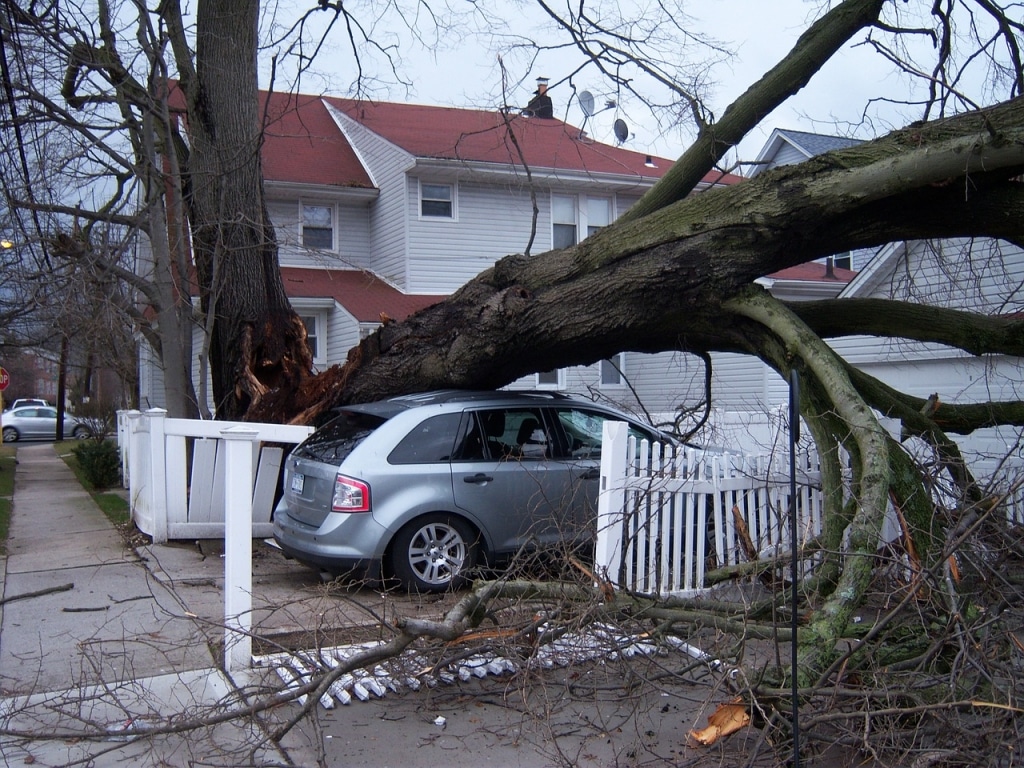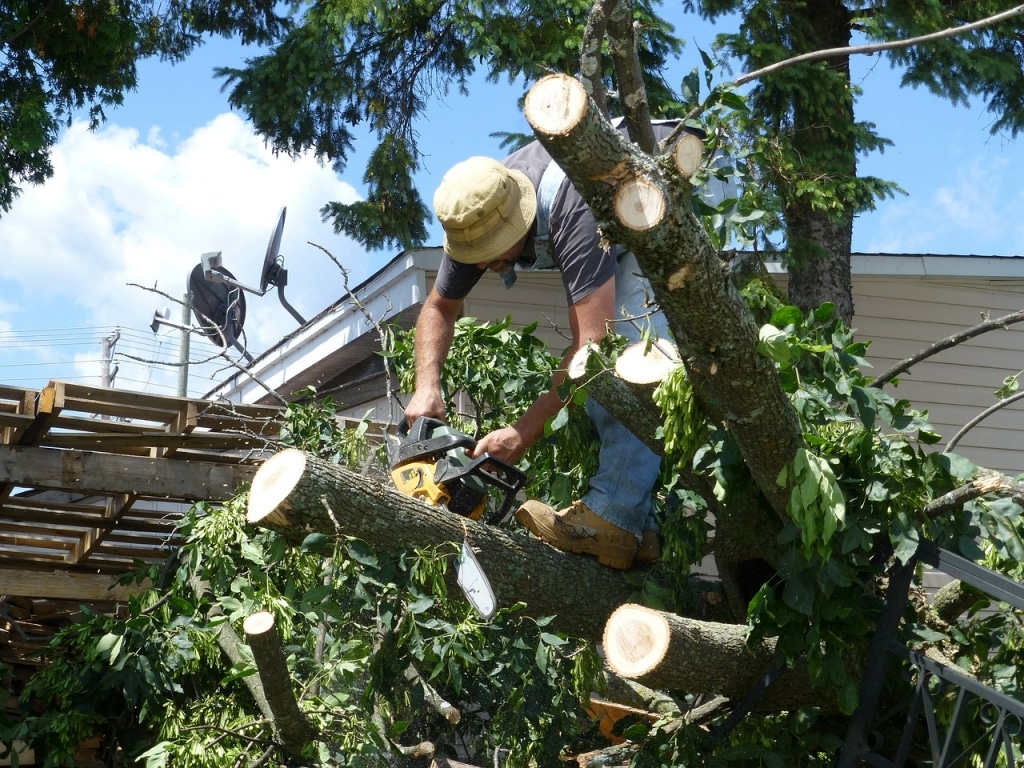Trees can be an attractive part of any garden, providing shade and adding greenery. However, when wet and windy weather arrives, trees can quickly turn into a hazard. The danger is particularly acute with a dead or dying tree, where internal decay can make the tree unstable and prone to collapsing without warning. When trees are knocked-over during periods of bad weather they can cause damage to properties and to people.
That’s why it’s important to get your trees checked on occasion by a professional arborist, especially if they show signs of weakness! A professional arborist or tree surgeon will be able to make recommendations on how to make the trees on your property safer.
Keeping Your Trees Safe
There are a number of things you can do to ensure the trees on your property are safe.
- Regular checks – book regular checks from a professional arborist. They can give you expert advice on how to care for your trees, and spot potential issues such as weakened spots
- Remove dead branches – one of the biggest causes of property damage from trees is from dead branches falling. Have dead branches removed every couple of years to protect your home. Dead branches are a natural part of the tree’s growing process, so their presence shouldn’t cause alarm
- Prune problem areas – if an issue is identified, such as a weakened area, then your arborist might suggest tree pruning. This can be a good alternative to tree removal or tree lopping, and when left to the professionals, ensures that the tree is still stable
- Avoid root cutting – tree roots have two functions, structural and feeding. If you cut roots you risk the entire structure of a tree, or could end up with a dead tree on your property which is also dangerous. Speak to an arborist before cutting tree roots
How dangerous are the trees on my property?
Luckily, the chances of being hurt by a tree is very low. Unluckily, your house and car are not quite so safe!
Unless you like to play under trees during thunderstorms, you’re much more likely to be killed in a road accident than by a tree falling on you! However, it’s still important to be careful, and trees can easily do a lot of damage to property if you ignore common warning signs.
Considering the risks and dangers associated with DIY tree removal, including the potential for personal injury, property damage, and the complexity of the task, it’s crucial to approach this with caution. DIY tree removal thinking might lead you to underestimate the challenges involved, such as not having control over where a tree falls, which could result in a tree toppling over in the wrong direction, causing significant damage to property or even personal injury. The risks of tree falls on homes, cars, power lines, or a neighbor’s property highlight the importance of understanding the intricacies of tree biology, decay, and chainsaw safety, all of which are crucial for safely removing trees.
If you’re worried about the trees on your property, here are a few things you can check, and some basic steps you can take to make them safer.
1. Weather Conditions
Certain weather conditions make tree failure more likely – like powerful storms, lightning, and even flooding. A combination of wet and windy is the most dangerous to trees, as the water-logged soil can destabilise the tree, meaning it doesn’t take much wind to knock it over.
This can also be an issue in areas prone to flooding. Soil that becomes extremely wet can’t hold onto tree roots, so they slip through the mud, making the trees easy to fell. This can sometimes happen when trees are planted in the wrong kind of soil, which is why it’s worth consulting with professional arborist when you plant new trees.
Wind alone isn’t usually enough to cause tree failure, although it can certainly knock off a few branches. Regular tree pruning can keep these stray branches from turning into wooden “window-seeking” missiles.
2. Power lines
Trees and power lines are not friends! Trees can carry electricity from nearby lines down through their trunks, zapping anyone (or anything) that comes too close.
Trees close to power lines are also at high risk of catching on fire – even if they seem safe. Electricity can arc from the line to the tree given the right conditions.
Perhaps the most danger from trees and powerlines comes from tall trees being blown over in high winds – pulling the line down from supporting towers or poles. As the line remains energized or “live”, this situation can be life-threatening for anyone nearby.
You should never try to cut down a tree that is close to – or touching – a power line. Instead, call a professional arborist who has the training and qualifications to handle the situation! Or better yet, talk to Perth Arbor Services for advice on the best varieties and locations for your yard and avoid a nasty situation altogether!
Remember to follow strict safety guidelines in relation to power lines, including:
- Checking for overhead power lines before you trim a tree or short hedge
- Contacting your local electricity company if working on a tree within two branch lengths of a power line
- Never cutting back trees or hedges that are touching lines
- Never climbing trees that are touching power lines
- Taking care when using a ladder close to power lines
Additionally, the risks associated with falling tree branches during DIY tree removal efforts, especially in proximity to power lines, cannot be overstated. Untrained individuals may face serious risks of injury or property damage from branches and debris falling unexpectedly.
3. Weakened areas
Trees have a strong structure and are sturdy, but if they are attacked by insects or certain types of pathogens, then they can lose their structural integrity. At that point, any windy or wet weather can cause issues.
Deep cavities, changes in leaf colour, split branches, and damaged roots can always be signs of an infected tree. A qualified tree surgeon can advise you on whether or not you can save the tree by lopping or pruning. But if the infection is to far-spread the whole tree will need to be removed.
4. Poor Engineering and Maintenance
Think about the structure of a building; it’s carefully engineered to be strong. If you start removing bricks, it becomes weaker and more susceptible to damage.
The same goes for trees. They can soon become damaged if people try to do their own tree maintenance such as:
- Tree lopping
- Pruning
- Cutting roots
- Removing major branches
Poor maintenance can lead to tree failure. For example, if the crown of a tree becomes too heavy due to lack of pruning, this can make it more dangerous during a storm. Heavy branches can also cause problems, so should be checked over, especially if you know wet and windy weather is on the way.
That’s why it’s important to use the services of a professional arborist, as they’ll be able to ensure the tree is safe after procedures such as pruning have been carried out. Hiring tree removal professionals is crucial due to their training in using equipment like chainsaws, ropes, cranes, and wood chippers, which are essential for safely performing tree removal jobs and mitigating the risks DIY homeowners may face without such expertise.
5. Human Error
As careful as we all try to be, sometimes accidents happen. From bumping into the trees in your yard as you back out the driveway, to digging that new garden a little too close to the roots, basic human errors can have a massive affect on tree health.
If you have hit a tree on your property, consider getting it checked by a professional arborist to see if it’s still stable. When carrying out construction, make sure you leave plenty of space for tree roots.
Contact the Professionals
If you’re concerned about a tree on your property, get in touch with Perth Arbor Services. As experienced, professional arborists, we can check your trees and give you advice on how to take care of them. Call (08) 9227 0010 for your free quote.


